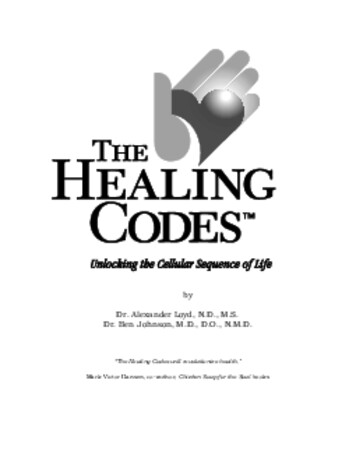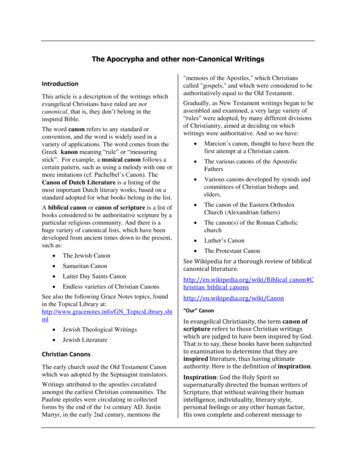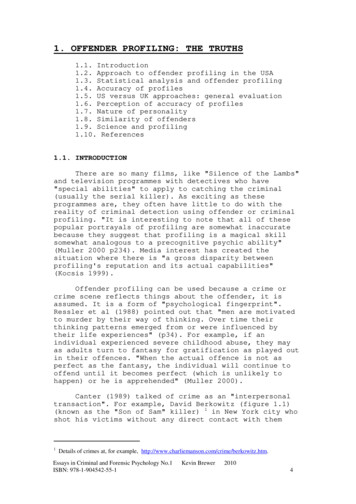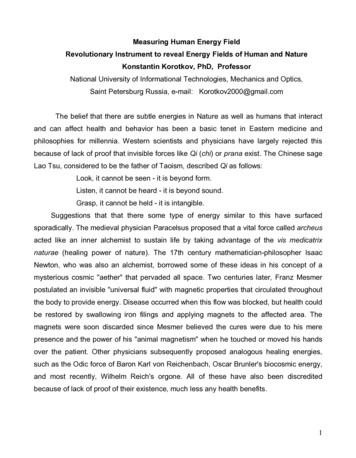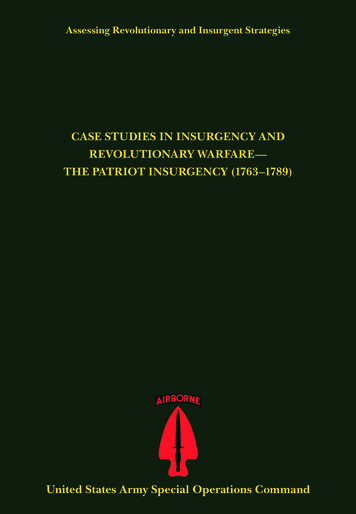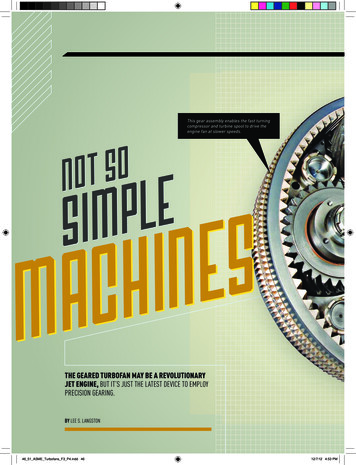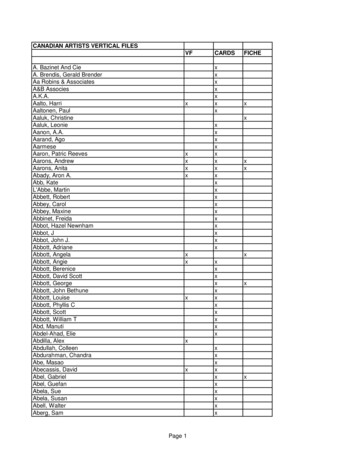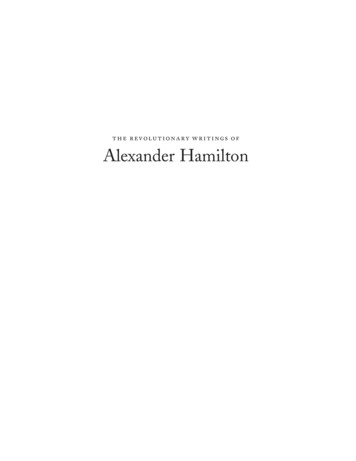
Transcription
the revolutionary writings ofAlexander Hamilton
alexander hamilton
the revolutionary writings ofAlexander Hamilton Edited and with an Introduction by Richard B. VernierWith a Foreword by Joyce O. ApplebyLiberty Fundindianapolis
This book is published by Liberty Fund, Inc., a foundationestablished to encourage study of the ideal of a society of free and responsibleindividuals.The cuneiform inscription that serves as our logo and asthe design motif for our endpapers is the earliest-known writtenappearance of the word “freedom” (amagi ), or “liberty.” It is taken from aclay document written about 2300 b.c. in the Sumeriancity-state of Lagash.Foreword, introduction, headnotes, annotations, index 䉷 2008Liberty Fund, Inc.Frontispiece: Alexander Hamilton, c. 1806, by John Trumbull (1756–1843),oil on canvas. 䉷 Board of Trustees, National Gallery of Art, Washington.Reprinted by permission.Cover art: Alexander Hamilton by Charles Willson Peale, from life, c. 1790–1795.Independence National Historical Park. Reprinted by permission.All rights reservedPrinted in the United States of America1 3 5 7 9 c1 3 5 7 9 p10 8 6 4 210 8 6 4 2Library of Congress Cataloging-in-Publication DataHamilton, Alexander, 1757–1804.The revolutionary writings of Alexander Hamilton / edited and with anintroduction by Richard B. Vernier; with a foreword by Joyce O. Appleby.p. cm.Includes index.isbn 978-0-86597-705-1 (alk. paper)—isbn 978-0-86597-706-8 (pbk. : alk. paper)1. United States—Politics and government—1775–1783. 2. United States—Politics and government—1783–1809. 3. United States—History—Revolution,1775–1783. 4. Hamilton, Alexander, 1757–1804—Political and social views.5. Political science—United States—History—18th century. I. Vernier, Richard B.II. Title.e302.h22 2008973.4092—dc222006052800Liberty Fund, Inc.8335 Allison Pointe Trail, Suite 300Indianapolis, Indiana 46250-1684
contentsForeword, by Joyce O. ApplebyIntroduction, by Richard B. VernierHamilton ChronologyA Full Vindication of the Measures of Congress,December 15, 1774The Farmer Refuted, February 23, 1775viixixxiii141Remarks on the Quebec Billnumber 1: June 15, 1775number 2: June 22, 1775141145Publiusletter 1: October 19, 1778letter 2: October 26, 1778letter 3: November 16, 1778157159162The Continentalistnumber 1: July 12, 1781number 2: July 19, 1781number 3: August 9, 1781number 4: August 30, 1781number 5: April 18, 1782number 6: July 4, 1782169172176182187194Index201
forewordJoyce O. ApplebyAmericans have an unusual relationship to the founding era of theirnation. They not only revere their many Founding Fathers but studytheir lives and writings with great avidity. Curators, scholars, and popularwriters respond to this taste with exhibits, books, videos, and conferences.Bicentennial commemorations of the American Revolution began in 1975and continued annually with reenactments, tours, and TV shows. Alexander Hamilton’s death at the hand of Aaron Burr prompted a majorexhibit in New York City in 2005; the tricentennial of Benjamin Franklin’s birth was marked by a year-long celebration in Philadelphia in 2006.Skeptics can verify this fascination by “googling” George Washington,Thomas Jefferson, Benjamin Franklin, John Adams, James Madison,Alexander Hamilton, and John Marshall, whose names pull up sites inthe thousands. Online bookstores follow suit with hundreds of titles,many of which were written in the past decade.Although most of the issues and values that divided America’s leadersin the nation-building years of the late eighteenth century are remotefrom those that stir us today, the passions aroused by these old contestspersist in the present. Readers often reveal a keen sense of partiality, ifnot partisanship, toward the revolutionary leaders. When Adams is riding high in popularity, esteem for Jefferson decreases. The same appliesto Jefferson and Hamilton. As we move into a season of bicentennialsof Marshall’s great decisions, these too will probably provoke criticismof his rivals, Jefferson and Madison.While clearly a Founding Father of great significance, Hamilton holdsa somewhat eccentric relationship to these other central figures. He diedyoung in a scandalous duel; he was never president; and his personalrelations lacked the rectitude so noticeable in George Washington. He
viiiforewordmight have fit in better in the British Parliament, where he could conceivably have found a place, given his birth in the Caribbean colony ofNevis. Yet few American leaders have ever been better loved than Hamilton was by the young Federalists who looked to him to carry them backto their rightful place at the head of the nation until death cut short hisbrilliant political career.What Hamilton had was genius, conspicuous even as a teenager. Extraordinary talent always attracts notice. Hamilton collected powerfulpatrons the way other young men acquire bad debts. His abundant gifts,well wrapped in personal discipline, earned him a passage from the islandof St. Croix, where he worked as a shipping clerk, to New York City tostudy at Columbia, then called King’s College. There Hamilton’s quickness, wit, charm, and diligence won him a new group of enthusiasticbackers who felt their faith in him well vindicated by his writings insupport of the Patriot cause.In a few years Hamilton passed from an academic prodigy to the mosttreasured of George Washington’s aides-de-camp. Making himself nearlyindispensable to Washington through his management of headquartersand report-writing, he also put together an intelligence network of spiesin New York City, which the British occupied throughout the war. Despite Washington’s reliance upon Hamilton as a secretary of the firstorder, Hamilton yearned for military action. Elevated to the rank oflieutenant-colonel, he managed to lead both an artillery and an infantryunit in important battles and finished his army career with a daring attackon one of the British positions at Yorktown.Given to neither the studiousness of Madison nor the wide-rangingintellectual curiosity of Jefferson, Hamilton gravitated to the technicalissues of governance. His moment came when Washington organizedthe first presidential administration under the new Constitution andchose him as secretary of the treasury. No man in the United States wasas prepared as Hamilton to use the new federal powers to craft a seriesof mutually enhancing statutes dealing with taxes, trade, and the revolutionary debt. He possessed a strong political philosophy, congenial to
forewordixthe Federalists who gravitated around Washington but at odds with theincreasingly popular democratic sentiments that triumphed with Jefferson’s election in 1801 and the subsequent sweep of successive Congressional elections.As the writings of this volume so well reveal, Hamilton was a naturalrhetorician in the best sense of that word. He wrote to persuade, not toshow off, and he mastered that indispensable skill of a popular author:knowing how to clarify complicated issues without yielding to distortingsimplifications. His archrival in Washington’s administration, Jefferson,paid reluctant tribute to Hamilton’s gifts when, in urging Madison totake up his pen to answer Hamilton’s newspaper essays, he called him a“mighty host.” In the earliest pieces we see the foundations of that brilliant career being set down and the contours of his core commitmentsestablished. We can also begin to see how those commitments were gradually adapted to embrace a more energetic vision of government by thetime of the Continentalist essays. Understanding something of Hamilton’s early writings thus serves to illumine some of the reasons for theearliest political and constitutional controversies of the republic.Hamilton epitomized what Jefferson feared in Federalist politics.When Hamilton had the chance to draft the economic policy for thenation, he relied on what he called the “durable and permanent existenceof rich and poor, debtor and creditor.” The wealthy few would developnew enterprises for the poor, whose lives would be regulated throughtheir economic dependence and, if necessary, the master-servant provisions of the Common Law. Convinced of the need for leadership fromdisinterested and educated gentlemen, Hamilton rejected the notion thatordinary farmers, storekeepers, and tinkerers might just as effectively usetheir resources for new, unsupervised ventures as wealthy entrepreneurswould. Yet it was the pool of capital and financial stability that Hamiltoncreated that enabled those petty entrepreneurs to prosper when Jeffersonbecame president.Illustrative of Hamilton’s socially conservative attitudes was his reaction to the idea of trade having the capacity of self-regulation. He rejected
xforewordaltogether the existence of a natural social harmony and called AdamSmith’s conviction, worked out in The Wealth of Nations, that the nationcould flourish without “a common directing power,” “one of those wildspeculative paradoxes, which have grown into credit among us, contraryto the uniform practice and sense of the most enlightened nations.”Like a master technician, Hamilton grasped the impinging details ofthings as disordered as the mishmash of state and national debts left aftereight years of fighting the revolution. Even to speak of debts is to imposea stability on what was in fact a jumble of bonds, bank notes, IOUs, andrequisitions of fluctuating value that had passed through hundreds ofhands. Only a passion for this kind of fiscal management could enticeanyone to take on such a staggering task as registering, calibrating, andstreamlining this tangle of papers into a stock issue that would make theUnited States solvent. With supreme confidence in his proposed measures, Hamilton turned a mass of bad debt into an asset by convertingthe debt into interest-bearing bonds that people wanted to purchase.The four geniuses of American nation-building—Jefferson, Hamilton,Madison, and Marshall—found their way unerringly to their métiers:Madison, the constitution writer; Jefferson, the creator of a democraticpolity; Marshall, the architect of liberal jurisprudence; and Hamilton, thefiscal wizard. All had interesting relationships with George Washington,whose great virtues were more personal and moral than intellectual. Theirwritings and stories reflect the character of the nation itself. It’s hard notto share the public’s delight in learning about them or, as in this case, inreading their own powerful words.
introductionRichard B. VernierConsidering the reputations of all the Founding Fathers, that ofAlexander Hamilton has taken the wildest swings. Over the past twocenturies, he has by turns been vilified as a cunning, aristocratic cryptomonarchist out to strangle American democracy in its cradle, and hailedas a steely-eyed visionary who secured the economic foundations of therepublic and fathered the modern American industrial state. How oneviews Hamilton will necessarily depend upon how one views the greatdebates of the early republic over the scope and nature of governmentpower, and of its role in shaping American society. Too frequently judgment on these essential questions is formed with reference only to Hamilton’s later works, most especially his contributions to the Federalist Papers. That is unfortunate, because such a reading necessarily slights thepowerful commitment Hamilton made early in his career to the revolutionary cause. Considering his earliest public writings presented in thisvolume, the most lurid portrayal of Hamilton as hostile to the principlesof American republicanism, as an ambitious opportunist who paid lipservice to republican government but actively pursued a system of electivemonarchy, is unsustainable. Indeed, Hamilton’s revolutionary writingsreveal the core values and beliefs of a young but genuine Whig. Whatthey suggest is the substitution of a revolutionary’s fears for his nation’sliberty, with a patriot’s desire for his nation’s power. To compare TheFarmer Refuted with The Continentalist essays is to be confronted by thevery great changes which had taken place in Hamilton’s thinking aboutthe challenges confronting American Independence. To compare TheContinentalist essays with his Federalist essays, and even more so hisfamous state papers on public credit, the bank, and manufactures is tobe struck with how much the grand themes sounded there remained
xiiintroductioncentral to his subsequent thinking.1 By collecting his earliest public writings together in one volume, readers will be better able to assess forthemselves Hamilton’s core commitments and his place in the Americanpolitical tradition. Did he remain constant in his most basic beliefs, ordid he indeed undergo a radical reconsideration of the nature of American political and economic liberty?The Revolution produced an outpouring of thousands of tracts andnewspaper essays, nowhere more ably analyzed and characterized than inBernard Bailyn’s classic Ideological Origins of the American Revolution.2Hamilton’s first tracts, written in the full flush of early Revolutionaryfervor, strike most of the familiar notes of patriotic Whiggism delineatedby Bailyn. There is the offhanded appeal to natural-law scholars—“Irecommend Grotius, Pufendorf, Locke”—the assertion that governmentrests upon consent, for the protection of natural rights. Real Whig notions of the grasping designs of power against liberty leave Hamiltonconvinced that British imperial policy clearly indicates a plot againstAmerican liberty, that the “system of slavery” being “fabricated againstAmerica” is the “offspring of mature deliberation.” And that the ultimateaim of the conspiracy was to fasten upon the colonies the system of heavytaxes and tithes, rule by standing army—in a word, to transform Americans into sheep to be shorn at will for the maintenance of a train ofcourt dependents—is likewise assumed by Hamilton. The profound legalism and constitutionalism of the Revolutionary
The Farmer Refuted, February 23, 1775 41 Remarks on the Quebec Bill number 1: June 15, 1775 141 number 2: June 22, 1775 145 Publius letter 1: October 19, 1778 157 letter 2: October 26, 1778 159 letter 3: November 16, 1778 162 The Continentalist number 1: July 12, 1781 169 number 2: July 19, 1781 172 number 3: August 9, 1781 176 number 4: August 30, 1781 182 number 5: April 18, 1782 187 number .



